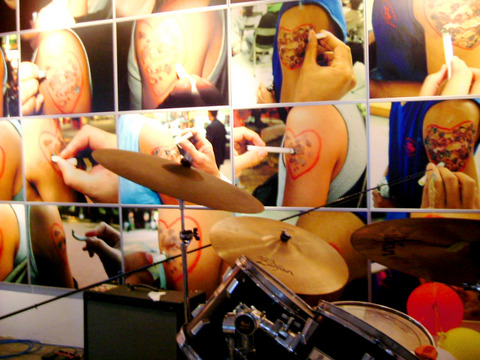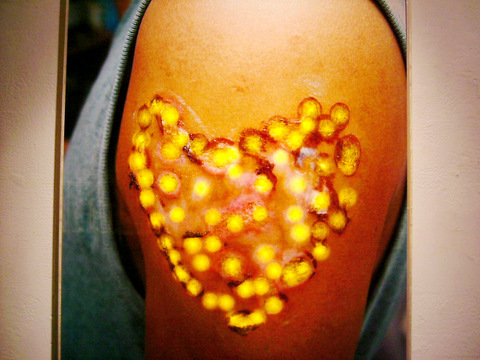If you're city-bound this summer, there are several refreshing art exhibitions to excite, soothe or even shock you. The works on view range from the lighthearted to the digitally interactive to outrageous performance art. In the exhibitions we see several art stereotypes: the professorial artist didactically telling his viewers about color theory; women as nurturers trying to give back to their communities; and the rock ‘n’ roll burnout artist.
Singing in Your Brain is Tsao Hsun-chih's (曹訓誌) first solo exhibition. He has four projects on display and takes a playful approach to dense color theory and ideas regarding perception.
The first work is a video of a woman singing the well-known Happy Birthday song, except there is no sound coming from her mouth. On seeing her mouth move, the viewer mentally fills in the melody. Tsao says suggestion is quite overpowering to the senses and that even though we use these faculties, we often do not pay much attention to them. Focusing on how our minds can fill in melodies or perceive color and sensations is a lot like “singing in one's brain.” In another room, Tsao uses two wall-sized projections to illustrate that point. In one, an optical illusion occurs as multicolored pixels seem to fill the screen, but the video was made with only two colors, red and green, and the mind is tricked into perceiving purple, yellow, orange, white, and gray.

PHOTOS: SUSAN KENDZULAK
Over at the Taipei Cultural Center is a small exhibition organized by Taipei Artist Village director, Su Yao-hua (蘇瑤華). Titled Women in Taipei it brings together three female artists who try to include community, family and place in their art. Hsu Chia-jung (許嘉容), the only featured artist to live in Taipei, uses her personal family photos to construct three-dimensional mannequins. Using transparent positive film, she stitches the snaps together and uses a light bulb placed inside the mannequin to create a glowing image.
Thai artist Teerawat Mulvilai exhibits the private journals of Southeast Asian women who have made Taiwan their home, while American Lexa Walsh exhibits her Immortalization Project in which she collects nostalgic objects from people and then conducts interviews to examine sentimental attachment. This modus operandi has become a trend at the Taipei Artist Village where visiting artists from around the world exchange personal mementoes with members of the local community.
In addition to the exhibition at the Cultural Center, the Taipei Artist Village runs a schedule of art, dance and performance programs that change monthly according to which artists are in residency at any given time. The artist village has a pleasant cafe with fresh baked goods so one can take a peaceful rest between gallery rounds.

At IT Park, performance artist Cheng Shih-chun (鄭詩雋) has become a transgressive rock star. Photos of a previous event show passers-by stamping out cigarettes into a heart shape drawn on his upper arm as if to say love hurts. To further make his point, photo lightboxes glow brightly where the embers burned his skin. A drum kit, guitars and amps are strewn throughout the gallery. This is no commercial exhibition, as sex toys, cash, and butts are the detritus of the painful and difficult passage of adolescence into adulthood.
Exhibition notes:
What: Singing in My Brain by Tsao Hsun-chih (曹訓誌)
Where: Sly Art Gallery, Lane 11, 15-2 Zhongshan Rd N Sec 2, (台北市中山北路二段11巷15-2號1樓)
When: Until Aug. 27What: Women in Taipei
Where: Taipei Cultural Center, Exhibition Room 3, (台北市立社教館第三展覽室2F), 2F, 25 Bade Rd Sec 3, Taipei (台北市八德路3段25號)
When: Until Aug. 31What: Cheng Shih-chun (鄭詩雋)
Where: IT Park, 2/3 F, 41 Yitong St, Taipei (台北市伊通街41號2-3摟) Tel:2507-7243
When: Tuesday to Saturday from 1:00pm to 10:00 pm; until Sept. 2

Most heroes are remembered for the battles they fought. Taiwan’s Black Bat Squadron is remembered for flying into Chinese airspace 838 times between 1953 and 1967, and for the 148 men whose sacrifice bought the intelligence that kept Taiwan secure. Two-thirds of the squadron died carrying out missions most people wouldn’t learn about for another 40 years. The squadron lost 15 aircraft and 148 crew members over those 14 years, making it the deadliest unit in Taiwan’s military history by casualty rate. They flew at night, often at low altitudes, straight into some of the most heavily defended airspace in Asia.

Many people in Taiwan first learned about universal basic income (UBI) — the idea that the government should provide regular, no-strings-attached payments to each citizen — in 2019. While seeking the Democratic nomination for the 2020 US presidential election, Andrew Yang, a politician of Taiwanese descent, said that, if elected, he’d institute a UBI of US$1,000 per month to “get the economic boot off of people’s throats, allowing them to lift their heads up, breathe, and get excited for the future.” His campaign petered out, but the concept of UBI hasn’t gone away. Throughout the industrialized world, there are fears that

Taiwan’s democracy is at risk. Be very alarmed. This is not a drill. The current constitutional crisis progressed slowly, then suddenly. Political tensions, partisan hostility and emotions are all running high right when cool heads and calm negotiation are most needed. Oxford defines brinkmanship as: “The art or practice of pursuing a dangerous policy to the limits of safety before stopping, especially in politics.” It says the term comes from a quote from a 1956 Cold War interview with then-American Secretary of State John Foster Dulles, when he said: ‘The ability to get to the verge without getting into the war is

Like much in the world today, theater has experienced major disruptions over the six years since COVID-19. The pandemic, the war in Ukraine and social media have created a new normal of geopolitical and information uncertainty, and the performing arts are not immune to these effects. “Ten years ago people wanted to come to the theater to engage with important issues, but now the Internet allows them to engage with those issues powerfully and immediately,” said Faith Tan, programming director of the Esplanade in Singapore, speaking last week in Japan. “One reaction to unpredictability has been a renewed emphasis on